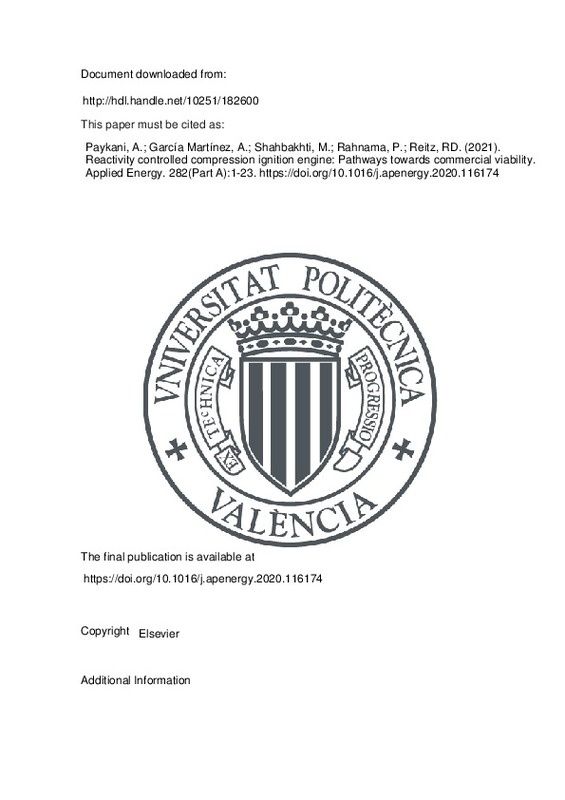JavaScript is disabled for your browser. Some features of this site may not work without it.
Buscar en RiuNet
Listar
Mi cuenta
Estadísticas
Ayuda RiuNet
Admin. UPV
Reactivity controlled compression ignition engine: Pathways towards commercial viability
Mostrar el registro sencillo del ítem
Ficheros en el ítem
| dc.contributor.author | Paykani, Amin
|
es_ES |
| dc.contributor.author | García Martínez, Antonio
|
es_ES |
| dc.contributor.author | Shahbakhti, Mahdi
|
es_ES |
| dc.contributor.author | Rahnama, Pourya
|
es_ES |
| dc.contributor.author | Reitz, Rolf D.
|
es_ES |
| dc.date.accessioned | 2022-05-13T18:05:50Z | |
| dc.date.available | 2022-05-13T18:05:50Z | |
| dc.date.issued | 2021-01-15 | es_ES |
| dc.identifier.issn | 0306-2619 | es_ES |
| dc.identifier.uri | http://hdl.handle.net/10251/182600 | |
| dc.description.abstract | [EN] Reactivity-controlled compression ignition (RCCI) is a promising energy conversion strategy to increase fuel efficiency and reduce nitrogen oxide (NOx) and soot emissions through improved in-cylinder combustion process. Considering the significant amount of conducted research and development on RCCI concept, the majority of the work has been performed under steady-state conditions. However, most thermal propulsion systems in transportation applications require operation under transient conditions. In the RCCI concept, it is crucial to investigate transient behavior over entire load conditions in order to minimize the engine-out emissions and meet new real driving emissions (RDE) legislation. This would help further close the gap between steady-state and transient operation in order to implement the RCCI concept into mass production. This work provides a comprehensive review of the performance and emissions analyses of the RCCI engines with the consideration of transient effects and vehicular applications. For this purpose, various simulation and experimental studies have been reviewed implementing different control strategies like control-oriented models particularly in dual-mode operating conditions. In addition, the application of the RCCI strategy in hybrid electric vehicle platforms using renewable fuels is also discussed. The discussion of the present review paper provides important insights for future research on the RCCI concept as a commercially viable energy conversion strategy for automotive applications | es_ES |
| dc.language | Inglés | es_ES |
| dc.publisher | Elsevier | es_ES |
| dc.relation.ispartof | Applied Energy | es_ES |
| dc.rights | Reconocimiento - No comercial - Sin obra derivada (by-nc-nd) | es_ES |
| dc.subject | Reactivity controlled compression ignition (RCCI) | es_ES |
| dc.subject | Control | es_ES |
| dc.subject | Performance | es_ES |
| dc.subject | Emissions | es_ES |
| dc.subject | Transient behavior | es_ES |
| dc.subject | Hybrid vehicles | es_ES |
| dc.subject.classification | MAQUINAS Y MOTORES TERMICOS | es_ES |
| dc.title | Reactivity controlled compression ignition engine: Pathways towards commercial viability | es_ES |
| dc.type | Artículo | es_ES |
| dc.identifier.doi | 10.1016/j.apenergy.2020.116174 | es_ES |
| dc.rights.accessRights | Abierto | es_ES |
| dc.contributor.affiliation | Universitat Politècnica de València. Departamento de Máquinas y Motores Térmicos - Departament de Màquines i Motors Tèrmics | es_ES |
| dc.description.bibliographicCitation | Paykani, A.; García Martínez, A.; Shahbakhti, M.; Rahnama, P.; Reitz, RD. (2021). Reactivity controlled compression ignition engine: Pathways towards commercial viability. Applied Energy. 282(Part A):1-23. https://doi.org/10.1016/j.apenergy.2020.116174 | es_ES |
| dc.description.accrualMethod | S | es_ES |
| dc.relation.publisherversion | https://doi.org/10.1016/j.apenergy.2020.116174 | es_ES |
| dc.description.upvformatpinicio | 1 | es_ES |
| dc.description.upvformatpfin | 23 | es_ES |
| dc.type.version | info:eu-repo/semantics/publishedVersion | es_ES |
| dc.description.volume | 282 | es_ES |
| dc.description.issue | Part A | es_ES |
| dc.relation.pasarela | S\435859 | es_ES |







![[Cerrado]](/themes/UPV/images/candado.png)

